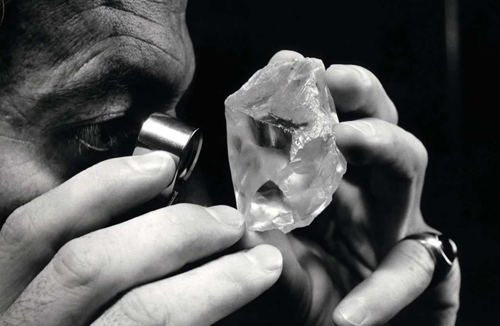
Founded by current CEO, Clifford Elphick, in July 2005, Gem Diamonds has made significant strides in the years that followed to become a leading global producer of high value diamonds. The company is the majority owner of the well-known Letšeng mine in Lesotho and is also in the process of developing its 100 percent owned Ghaghoo mine in Botswana.
As of 1 January, 2013, the company recorded total gross resources, including reserves, of 25.8 million carats containing in 409.8 million tonnes, with an average diamond price of US$625 per carats. Reserves meanwhile totalled 3.5 million carats contained in 86.4 million tonnes, with an average diamond price of US$831 per carat.
The Letšeng mine is famous for its production of large, top colour, white diamonds, making it the highest average dollar per carat kimberlite diamond mine on the plant. Operated by De Beers from 1977 until 1982, the mine restarted operations in 2004 before being acquired by Gem Diamonds in late 2006 at a cost of US$118.5 million. In the five years from 2006 until 2011 annual production under Gem Diamonds would go on to rise from 55,000 carats to 112,367 carats.
Letšeng processes ore from two kimberlite pipes, Main and Satellite, both bearing extremely low grade ore, under two carats per hundred tonnes, as well as from existing stockpiles. The mine can currently process around seven million tonnes of ore a year, producing about 100,000 carats.
Since 2006, the mine has been responsible for producing four of the twenty largest white gem quality diamonds ever discovered. These include the Letšeng Star, a 550 carat white diamond recovered from the mine in August 2011, which remains among the top 15 largest white diamonds on record. This discovery was preceded by that of the 478 carat Light of Letšeng white diamond in 2008, the 603 carat Lesotho Promise white diamond in 2006, and the 493 carat Letšeng Legacy white diamond in 2007.
More recently the company again made the headlines with the discovery of a rare 12.47 carat blue diamond from the Letšeng mine. With blue diamonds being among the most sought after of the coloured diamonds, this particular diamond subsequently went on to sell for $7.5 million, a record-breaking price for the Letšeng mine, at auction in Antwerp.
In January 2012, Gem Diamonds commenced with Project Kholo, the name given to its plan to expand the Letšeng mine. With a brief to ramp up the mine to full production by July 2014, Project Kholo consists of a number of work streams, all directed towards increasing the mine’s revenues, including increasing ore throughput, improving diamond liberation, reducing diamond damage and increasing the amount of production available for cutting and polishing.
Heading north out of Lesotho into Botswana we find the Ghaghoo mine with its Gope 25 kimberlite pipe. Located some 45 kilometres within the eastern border of the Central Kalahari Game Reserve, Gem Diamonds is having to operate within the highest of environmental standards in order to ensure minimal environmental impact from the mine’s development.
In early 2010, three independent experts conducted an updated resource statement for Ghaghoo on behalf of the company. An increase in grade from new statistical modelling, and volume through the re-interpretation of drilling results, led to an upgrading in Ghaghoo's total carat resource to 20.5 million carats, at an increased average US$162 per carat, with a total in situ value of US$3.3 billion. It was also during valuation work that two blue diamonds were also recovered from samples.
Upon consideration of its findings the company presented the Botswana government with an updated study of the mine, including the option for an underground mine. With this proposal agreed, construction of phase one of the Ghaghoo underground mine began in 2011 following Gem Diamonds’ board’s approval of a $US85 million capital budget. With an estimated production capacity of 720,000 tonnes per annum, the objective of phase one will be to confirm the grade, diamond prices and the recovery processes, including the use of autogenous milling, which is expected to increase diamond liberation. Construction of the processing plant will be commissioned early in 2014 and will be ready for the second half of 2014 ore delivery date.
The Gem Diamonds group is committed to the principles and practices of sustainable development, believing that adopting an active and engaged approach to sustainability is key to its ability to meet its responsibilities to its stakeholders, shareholders, employees and the communities within which it operates. For both ethical and pragmatic business reasons, the company is committed to the strict maintenance of internationally recognised standards of health and safety, environmental, social, and economic and business management.
Moving forward the company has a very clear and consistent growth strategy based on the successful expansion of the Letšeng mine and the development of the Ghaghoo mine in Botswana. Meanwhile it will continue to seek to maximise revenue and margin from its production of rough diamonds by pursuing diamond cutting, polishing and sales and marketing initiatives further along the diamond value chain. With favourable supply and demand dynamics expected to benefit the industry over the medium to long term, particularly at the high end of the market which is supplied by Gem Diamonds, this strategy positions the company strongly to generate attractive returns for shareholders well into the future.
Written by Will Daynes, research by Jeff Abbott



 GemDiamonds-Africa-Mining-Mar14-Bro-s.pdf
GemDiamonds-Africa-Mining-Mar14-Bro-s.pdf








